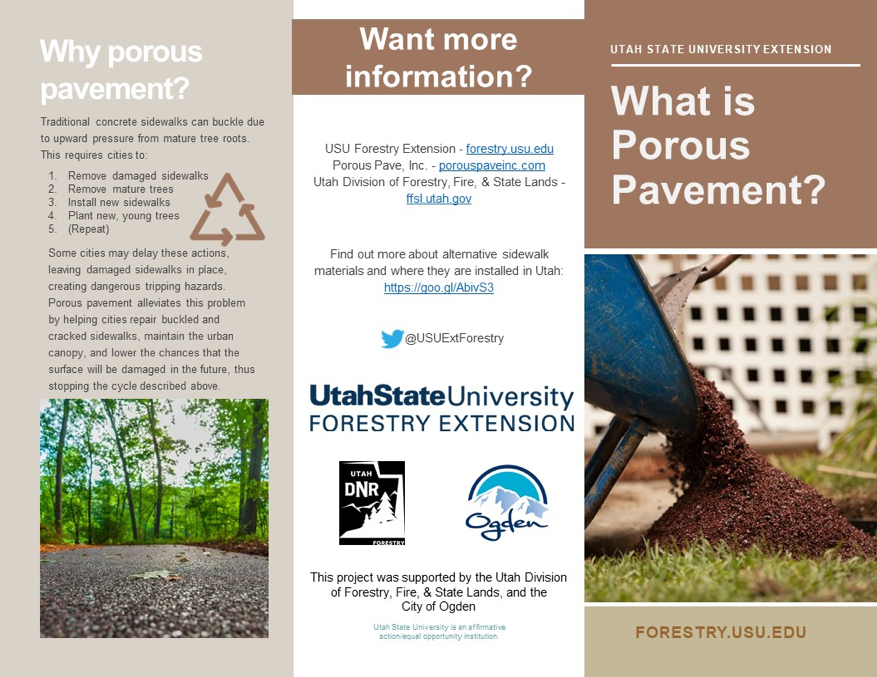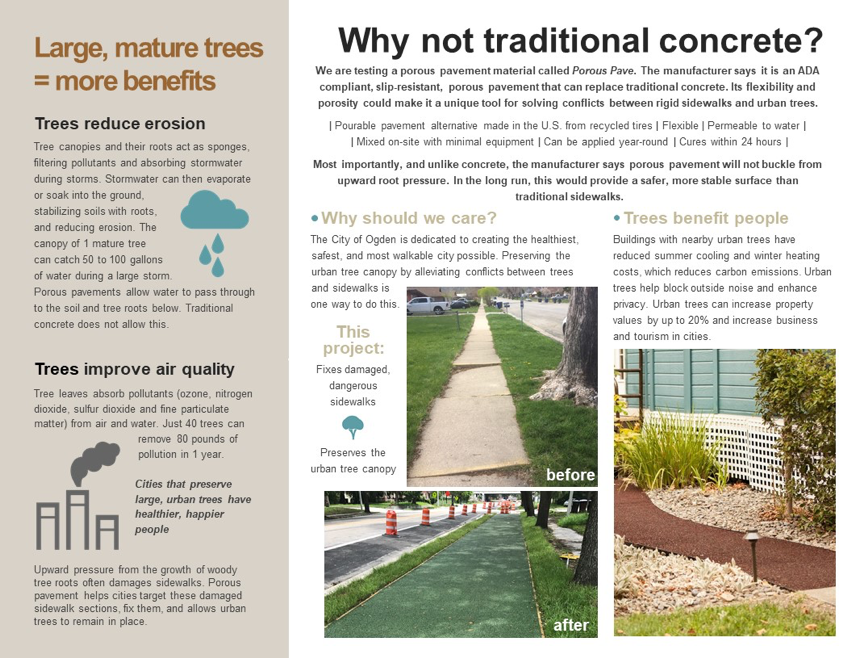 |
December 2019
|
December 2019 // Volume 57 // Number 6 // Tools of the Trade // v57-6tt3
Paving the Way: A Plan for Tackling Urban Forestry Challenges and Gaining Public Support
Abstract
The benefits of urban trees are well known; however, tree roots often damage sidewalks, requiring root cutting, tree removal, and sidewalk replacement. We used alternative materials that allowed for tree retention and sidewalk replacement at two sites in northern Utah. From these projects, we developed a plan to help Extension professionals build support for novel urban forestry techniques and tools by forming collaborative partnerships, conducting public and professional outreach, and evaluating public opinions through the use of drop-off/pick-up surveys. Our project highlights the importance of having a proactive outreach plan when conducting Extension programming that involves new practices and products.
Introduction
Urban forests provide many benefits to the public; however, their coexistence with humans and built infrastructure (e.g., sidewalks) creates complex problems that often require creative management (Dwyer, Nowak, & Watson, 2002). One common problem that frequently occurs in urban forests is the damage large tree roots can cause to sidewalks (Figure 1). Addressing this problem requires removing roots or entire trees and replacing sidewalks to provide safe and accessible footpaths for the public. To prevent the removal of valuable urban trees, foresters may use techniques and tools such as root cutting, root barriers, structural soils, permeable pavement, or flexible sidewalk tiles (Grabosky & Bassuk, 1995; Grabosky, Bassuk, & Marranca, 2002; Mullaney, Lucke, & Trueman, 2015; Smiley, 2008; Xiao & McPherson, 2011). Although these solutions can be more costly than tree removal, they often lead to less maintenance and allow valuable urban trees to stay in place (Dettenmaier & Kuhns, 2016).
Figure 1.
Typical Damage from Tree Roots Lifting and Buckling Sidewalks
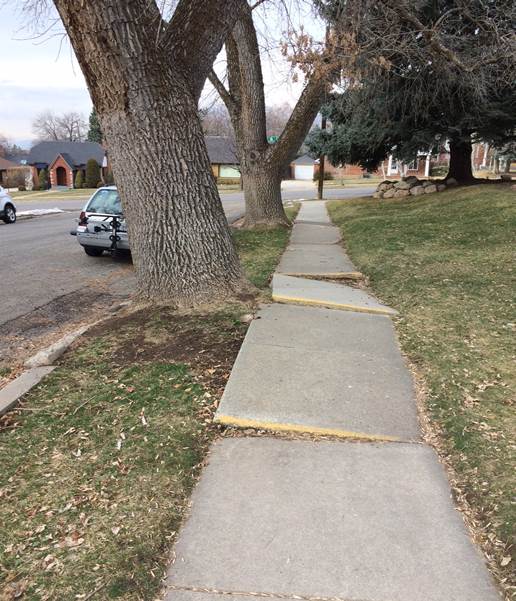
Previous research on permeable pavement has indicated improvements in timing of stormwater flows, runoff reduction, and water quality resulting from its use (Bean, Hunt, & Bidelspach, 2007; Booth & Leavitt, 1999; Brattebo & Booth, 2003; Pratt, Mantle, & Schofield, 1989). Best practices for design and construction involving permeable pavement have been described by Hein and Schaus (2013). However, we are not aware of any previous studies examining the use of permeable pavement specifically to minimize tree–sidewalk conflicts. Here we describe a project whereby we installed permeable pavement to reduce tree damage and loss, and we suggest a plan that facilitates using new urban forestry techniques while also assessing and helping assure public and professional support.
Project Background
Partnerships between Extension professionals and other agencies or organizations can make Extension program implementation easier, especially when project objectives include technology transfer of new and unfamiliar ideas or innovations (Monroe, McDonnell, Hermansen-Baez, Long, & Zipperer, 2007). We successfully partnered with multiple agencies to complete a project involving use of unfamiliar sidewalk materials in neighborhoods in northern Utah. Our team of Utah State University Extension Forestry staff acquired funds from a community forestry partnership grant from the Utah Division of Forestry, Fire, and State Lands to demonstrate a way to minimize tree–sidewalk conflicts while retaining urban trees throughout Utah. We investigated and installed two alternative sidewalk products—flexible sidewalk tiles in 2015 and permeable pavement in 2018 (the latter solution is shown in Figure 2). In conjunction with our two demonstration projects, we administered surveys of residents living near both installations to assess the acceptability of and support for future use of the solutions we implemented.
Figure 2.
Damage Shown in Figure 1 Repaired with Permeable Pavement Material

Five-Step Plan
From our experiences and survey results, we developed a plan to help other Extension professionals and urban/community foresters form collaborative partnerships to address similar urban forestry challenges. The plan (Figure 3) comprises the five steps we used to successfully implement our urban forestry project, with specific recommendations for each step.
Figure 3.
Plan for Conducting Urban Forestry Projects Involving New (Unfamiliar) Techniques Based on Implementations in Two Utah Cities
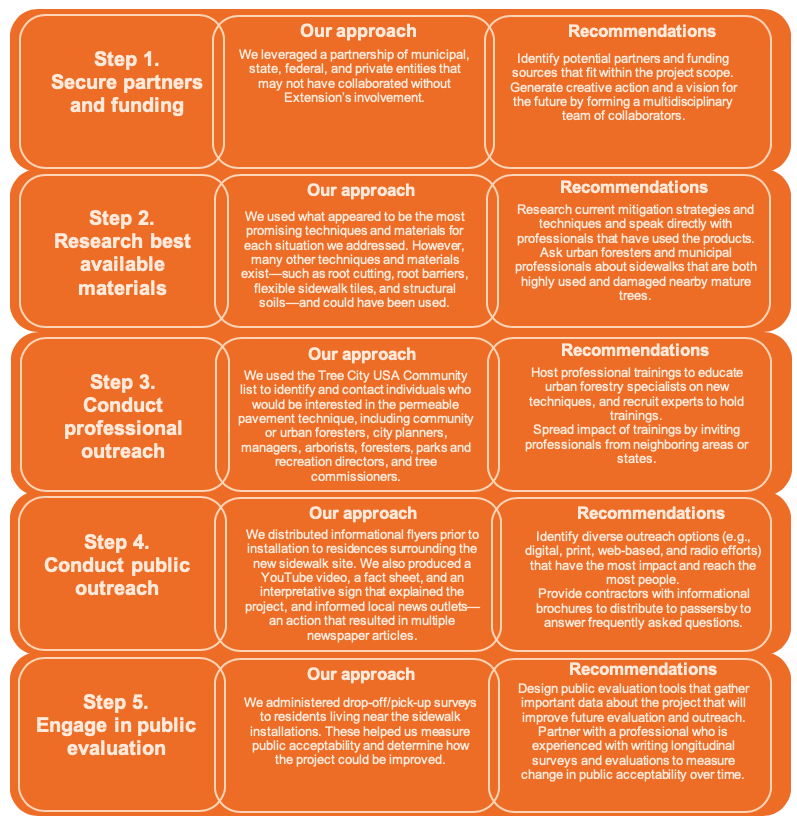
Importance of Public Outreach and Evaluation
We found that public outreach and evaluation (Steps 4 and 5 in Figure 3) were extremely important to the success of our project; we expand on those findings here.
- Distribute concise and understandable educational brochures prior to the beginning of a project or construction. Survey results from the flexible sidewalk installation (in 2015) were favorable; however, residents mentioned that they would have liked information on the installation prior to construction. In response (Step 4, Figure 3), we created a concise brochure (see appendix) and distributed it to residents before the permeable pavement installation in 2018. Support for continued use of alternative sidewalk material was 78% in 2015, when no advance information was provided, and 92% in 2018, when preconstruction educational brochures were distributed.
- Provide ample opportunities for nearby residents to express opinions and ask questions, and then implement this feedback in future projects. We approached every home within one city block of the installation in 2018 to distribute brochures, and when residents were home they could talk to and ask questions of our technician. Also, with the postconstruction survey we conducted, we provided space on the survey instrument where residents could comment and ask remaining questions. Some residents in 2018 expressed disappointment that the installation did not match the appearance of the existing sidewalk, suggesting that it instead had created an unattractive, patchy look (Figure 4). The product was applied only to sidewalks damaged by tree roots, whereas residents would have preferred a uniform-looking sidewalk. Despite this circumstance, most residents supported using the product to replace buckled sidewalks (91%) or metal tree grates (78%), and nearly all mentioned that retaining a mature, urban tree canopy was extremely important (95%). Soliciting and listening to public opinions allowed us to learn and to educate contractors and decision makers on ways to complete projects with increased public support in the future.
Figure 4.
Demonstration of Patchy Appearance Identified as Undesirable by Surveyed Residents at One Alternative Sidewalk Installation Site
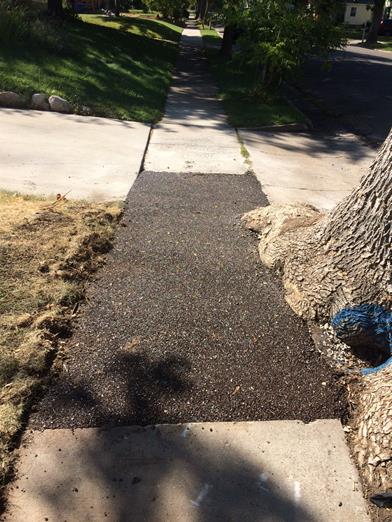
- Future researchers and practitioners should employ additional evaluative tools to gauge public opinions and calculate costs and benefits of projects. Conducting focus group sessions in conjunction with resident surveys could provide a more in-depth understanding of resident perceptions and opinions on urban forestry projects and would allow project collaborators to engage with the public in a meaningful way. For example, the city engineer in 2018 was interested in our survey results, and focus group research would have allowed him and other professionals the opportunity to engage in beneficial interaction with the public.
Conclusion
From our experiences installing alternative sidewalks in northern Utah, we identified five key steps to building support for novel urban forestry techniques and tools while engaging the public and professionals in education and outreach. By forming collaborations with various experts, we were able to approach the project in a multidisciplinary manner. We could use the best techniques and tools for the project and engage the public and professionals in meaningful ways. This engagement allowed us to design surveys that generated pertinent data on how to approach future projects and continue building public support for such projects. Individuals interested in tackling urban forestry challenges, and other municipal challenges, should consider using the plan provided herein as a guiding tool. Examples of successes and challenges associated with future use of the plan can be synthesized to continue enhancing the plan over time, and, in turn, continue building on the success of these rewarding projects.
References
Bean, E. Z., Hunt, F. W., & Bidelspach, A. D. (2007). Evaluation of four permeable pavement sites in eastern North Carolina for runoff reduction and water quality impacts. Journal of Irrigation and Drainage Engineering, 133(6), 583–592. https://doi.org/10.1061/(ASCE)0733-9437(2007)133:6(583)
Booth, D. B., & Leavitt, J. (1999). Field evaluation of permeable pavement systems for improved stormwater management. Journal of the American Planning Association, 65(3), 314–325. https://doi.org/10.1080/01944369908976060
Brattebo, B. O., & Booth, D. B. (2003). Long-term stormwater quantity and quality performance of permeable pavement systems. Water Research, 37(18), 4369–4376. https://doi.org/10.1016/S0043-1354(03)00410-X
Dettenmaier, M., & Kuhns, M. R. (2016). Tree/sidewalk conflicts: One way to save trees (Report No. 030, Utah Forest Facts). Logan, UT: Utah State University Forestry Extension.
Dwyer, J. F., Nowak, D. J., & Watson, G. W. (2002). Future directions for urban forestry research in the United States. Journal of Arboriculture, 28(5), 231–236.
Grabosky, J., & Bassuk, N. (1995). A new urban tree soil to safely increase rooting volumes under sidewalks. Journal of Arboriculture, 4(21), 187. Retrieved from http://www.hort.cornell.edu/uhi/research/articles/JArb21(4).pdf
Grabosky, J., Bassuk, N., & Marranca, B. Z. (2002). Preliminary findings from measuring street tree shoot growth in two skeletal soil installations compared to tree lawn plantings. Journal of Aboriculture, 28(2), 106–108. Retrieved from http://joa.isa-arbor.com/request.asp?JournalID=1&ArticleID=34&Type=2
Hein, D. K., & Schaus, L. (2013, January). Permeable pavement design and construction: What have we learned recently? Paper session presented at the Second Conference on Green Streets, Highways, and Development. https://doi.org/doi:10.1061/9780784413197.003
Monroe, M. C., McDonell, L., Hermansen-Baez, L. A., Long, A. J., & Zipperer, W. (2007). Building successful partnerships for technology transfer. Journal of Extension, 45(3), Article 3TOT6. Available at: https://joe.org/joe/2007june/tt6.php
Mullaney, J., Lucke, T., & Trueman, S. J. (2015). A review of benefits and challenges in growing street trees in paved urban environments. Landscape and Urban Planning, 134, 157–166. https://doi.org/10.1016/j.landurbplan.2014.10.013
Pratt, C. J., Mantle, J. D. G., & Schofield, P. A. (1989). Urban stormwater reduction and quality improvement through the use of permeable pavements. Water Science and Technology, 21(8–9), 769–778.
Smiley, E. T. (2008). Comparison of methods to reduce sidewalk damage from tree roots. Arboriculture and Urban Forestry, 34(3), 179–183.
Xiao, Q., & McPherson, E. G. (2011). Performance of engineered soil and trees in a parking lot bioswale. Urban Water Journal, 8(4), 241–253.
Appendix
Informational Brochure Distributed to Residents Living Near Sidewalk Installations in August, 2018
